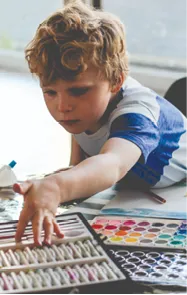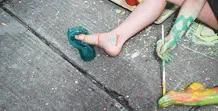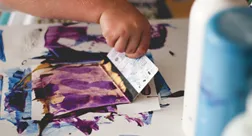![]()
chapter 1
Art Projects
When I first started staying home, I found that it was incredibly easy to fall into a trap of planning all our activities around our kids without much, if any, consideration of the things that I like to do. Given that they were so young (ages one and two and a half), that meant planning typical kid activities around their nap schedules, mealtimes, bathroom trips, and so on. It’s a natural thing to do and it makes sense. But I felt like I was starting to lose myself just a little bit, and I came to the realization that it was perfectly fine to plan some things to do with the kids that I liked too. And art was one of those areas in which I first started to make that transition.
When the first few art projects (such as cutting shapes out of paper) were not provoking the kind of creativity I was aiming for, I realized that my focus should be more on the art of making—in other words, putting process over product. The kids and I started undertaking more open-ended art projects. Even though they don’t always end up as frame-worthy pieces, we all enjoy the process so much more. My general approach is to give the kids freedom to create how they want—even within the confines of a particular project. For example, I might pick the particular art media we use, such as watercolors, but have them decide what they want to do with it. Or I might have a more focused project, such as creating pop art of themselves for Father’s Day, but let them pick their own colors. I love watching the kids make choices, figure out how and what they want to do, and follow the paths down which their creativity takes them. By exposing them to activities I enjoy, they’ve started to develop their own interests. But I still have fun and stay interested. And that gives me more satisfaction at the end of the day, and in turn, I think makes it a better experience for our kids as well.
![]()
Preparing for Art Making
Before gathering materials, I find that it’s helpful to spend some time thinking about what kind of art you’d like to make with your kids. To come up with project ideas, I think about the kind of art I enjoyed making when I was young, spend time researching ideas online, and peruse kid art blogs and books. We have been inspired by art we see on our field trips and sometimes think of our own projects based on those observations, but I generally have a running list of art projects we’d like to try.
If you first gather ideas about the kind of art you’d like to make, then you can more easily find ways to purchase art supplies cost-effectively. You can save by buying in bulk, so I try to use the same materials for several different projects. After our art supplies were pretty well stocked, I found it much easier to set the kids up with simple activities, such as just coloring with markers. (See the Resources section for our list of favorite art suppliers.)
As you can tell, it’s also important to consider the age of your children and their particular personalities before choosing a project. I always try to choose projects that both of my children can participate in, even if it’s in a slightly different way. For example, we did a spray-painted coffee filters project that was well suited for my oldest, Kane, who had developed enough motor skills to physically squeeze a bottle full of watercolors. Cameron wasn’t quite at that stage, but she was perfectly capable of using a paintbrush to achieve a similar effect. I let her try using the squeeze bottle but had the backup available so she could still participate and not get frustrated.
I know that there are some projects one of our kids will enjoy more than the other, but I encourage both to try. I also offer options that might better suit their particular personalities. We certainly have moments when one decides not to participate, and I don’t force them. But I find that they have a hard time not joining once we get started.
Cameron has an affinity for painting on her body instead of on whatever traditional media we’re using, so I quickly learned to set up workspaces to allow her to do that. I once taped large sheets of paper to the wall around their bathtub and set them up with brushes and glow-in-the-dark paint. I have a portable black light that I plugged in far away from the tub and obviously kept the tub empty for safety. Kane went right to work painting on the paper, but all Cam wanted to do was paint herself from head to toe. When they were done, all I had to do was take down the paper and run the tub.
I’ve also found it’s helpful to try to keep a laid-back attitude toward art and mess (which doesn’t always work). By now, it should be fairly obvious that I don’t mind a little mess. But if the idea of having a fully painted child run down the hallway or having glitter strewn throughout your living room strikes fear in your heart, then don’t do it! Find a project that is creative and fits your comfort level. It’s not going to be fun for anyone if you have to obsessively sweep under your child’s chair throughout the whole project.
Once you have the materials and an idea of what project you and your kids would like to do, make sure you think through how much time you’ll need for the project; no one likes to be rushed. I also like to set up the art project area, gather the materials, and then spend some time talking to my kids about what we’re going to do. If a project needs to be done in stages, don’t put out all of the materials at once. You’ll just get frustrated when the kids inevitably go straight to stage four. I also occasionally show my kids examples of a finished project, when available, particularly if we are trying to create in the style of a certain artist. But I generally like to try to keep their minds open and not make them feel like they have to create in a certain way.
To that end, I sometimes join in, but have found that when I do, my kids frequently try to imitate what I’m doing or ask me to do things for them. So more often, I just sit with them and talk about what they’re doing or wherever else our conversation leads. I’m also perfectly comfortable setting them up with an easy project and doing something else nearby. Although I’d love to do art all day, I also use it as a time to keep them occupied while I need to get other things done. I’ve had several stern conversations with the dishes, but they still appear incapable of washing themselves.
![]()
Art Project Ideas
As I mentioned earlier, I like to have a list of projects handy when we need an idea to get us started. These are our favorites, with additional options noted for some activities. As you gather materials on the lists, make sure you have enough for all children participating. You can adjust each project to best suit your child’s age and temperament, but most of them we’ve done in some form since Cam was one year old. (Remember: Don’t underestimate them!)
We love to use BioColor paint,
which retains the individual paint
colors when mixed and scraped
together more than regular tempera
paint. But mixing colors is also
another important skill, so
regular tempera paint is
fine too.
![]()
Big Painting
Both of our kids love to get messy while making art. In fact, I often set them up for art projects in swimsuits because I know that whatever they’re doing, it’s going to be all over them. And big painting might be their favorite messy art project for that very reason. On top of the good fun, I love big painting because it helps develop gross and fine motor skills, teaches them a bit about restraint (in terms of how much paint to use), and stimulates creative storytelling for them.
They are both big fans of making up stories about what they’re painting as they are painting it. I’m not sure if it’s because this is such an active way of making art or because of the fluid nature of the media, but when they move the paint around with the scraper, the paint seems to come alive for them. Our kids view the paint as doing something while they create art and often describe the paint as actual physical matter—like water or lava—that ...



